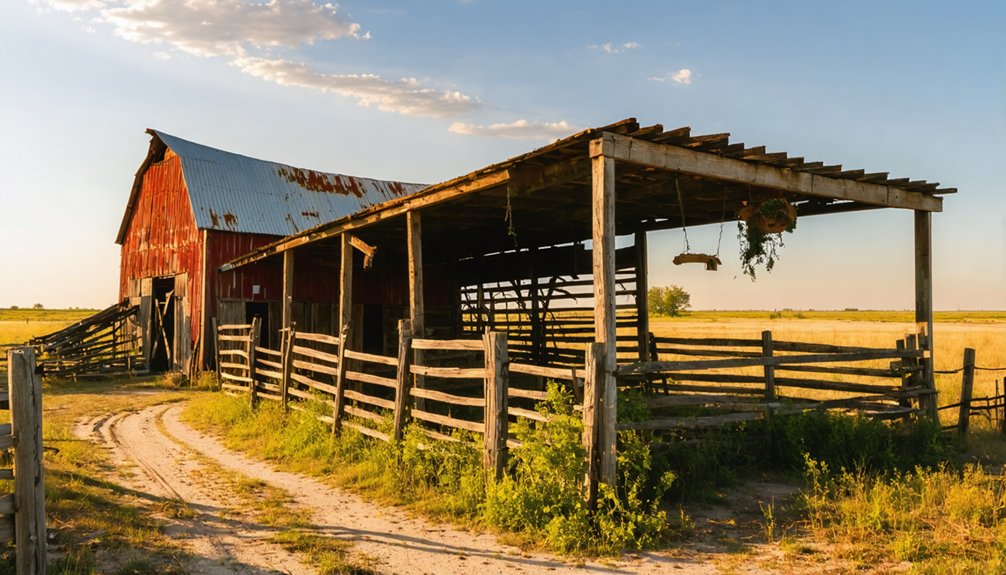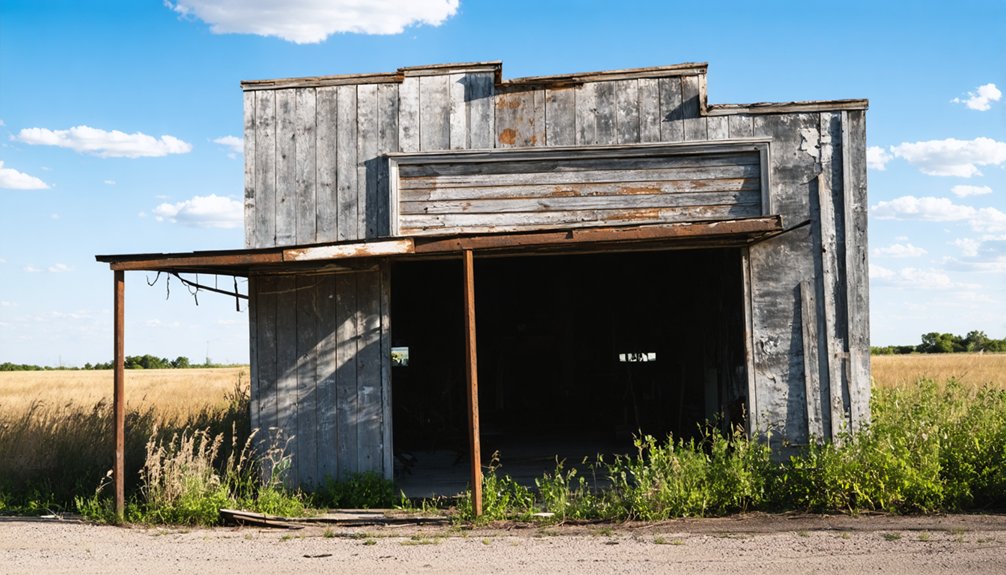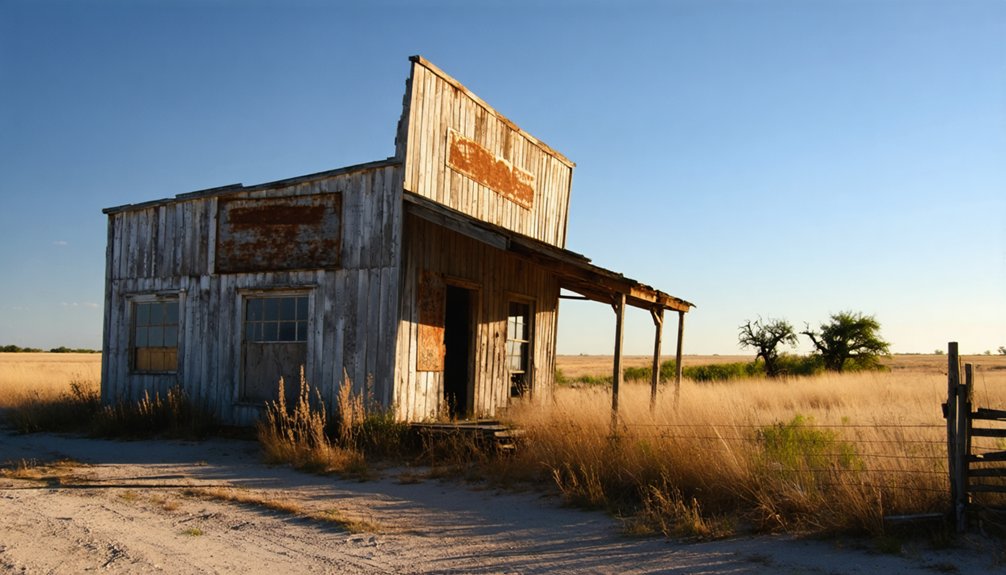You’ll find Proffitt along Elm Creek in west-central Young County, Texas, where Methodist minister Robert S. Proffitt established this frontier settlement in the early 1860s. The town weathered violent raids from Comanche and Kiowa tribes, including the devastating 1864 Elm Creek Raid that claimed multiple lives and 10,000 cattle. While the community once thrived with churches, schools, and a Masonic lodge, today’s ghost town holds fascinating tales of pioneer determination and survival in Texas’s untamed frontier.
Key Takeaways
- Proffitt, Texas, established in the 1860s along Elm Creek, transformed from a thriving frontier settlement into an isolated ghost town.
- The town was founded by Methodist minister Robert S. Proffitt, who established religious services and donated land for community buildings.
- Historical structures included a cotton gin, general store, churches, schools, and Masonic Lodge, though few remnants remain today.
- The town’s decline was influenced by Native American raids, with the devastating 1864 Elm Creek Raid marking a significant turning point.
- Today, Proffitt’s ghost town status is preserved by limited accessibility due to divided land ownership, with the cemetery remaining as historical evidence.
The Methodist Minister Who Started It All
While many Texas ghost towns emerged from mining booms or railroad development, Proffitt began with a man of God and his cattle. Robert S. Proffitt, a Methodist minister from Tennessee, founded this west-central Young County settlement in the early 1860s along Elm Creek.
You’ll find his Methodist influence woven deeply into the town’s origins, as he led religious services that became the heartbeat of community gatherings. His son’s life was tragically cut short during the Indian raid of 1867. After the Civil War, he generously donated land for the establishment of key community buildings.
Unlike many frontier preachers, Proffitt didn’t rely solely on his ministry. He established strong economic foundations through cattle ranching and storekeeping, proving himself as capable in business as he was in the pulpit.
His practical approach to frontier life, combining spiritual leadership with ranching skills, helped attract settlers and create a sustainable community in this remote Texas location.
Early Days Along Elm Creek
Robert S. Proffitt and fellow settlers found Elm Creek‘s terrain perfect for their ranching ambitions in the 1860s. You’ll notice they chose this spot wisely – the creek’s connection to the Brazos River provided critical water access for their cattle operations.
Life along Elm Creek wasn’t just about ranching, though. The fertile bottomlands let settlers grow crops, while Proffitt’s store became a significant hub for the scattered homesteads. Proffitt’s journey began when he migrated from Tennessee in 1852, initially settling in Hood County before establishing the town.
The community faced devastating losses when ten settlers died during the violent Elm Creek Raid on October 31, 1864.
But these early settler experiences were marked by danger. Kiowa and Comanche raids threatened creek navigation and daily life, culminating in the devastating Elm Creek Raid of 1864.
Despite this violence, the community persevered. They established essential structures near the creek, including a church, school, and Masonic lodge, creating a resilient frontier settlement that adapted to the challenging landscape.
Life During the Civil War Years
During the turbulent years of the Civil War, the newly established community of Proffitt faced a perfect storm of challenges along the Texas frontier.
You’d find settlers maintaining constant vigilance while trying to build a life along Elm Creek and the Brazos River, carrying firearms as they tended their cattle under the ever-present threat of raids.
Life wasn’t easy for these freedom-seeking families. When approximately seventy-five Native Americans attacked in July 1867, they killed three young men – Patrick Proffitt, Rice Carlton, and Reuben Johnson – during a cattle branding. The boys fought bravely as they retreated three-fourths of a mile before being overtaken.
Despite such devastating losses, the community’s resilience shone through. They established essential institutions, including a church that doubled as a school and Masonic lodge, demonstrating their determination to create stability amid the chaos of Civil War-era Texas. The pioneering Proffitt family had arrived just a few years earlier, with John Proffitt generously donating land to build the church.
The Challenges of Indian Raids
Proffitt settlers faced relentless Comanche and Kiowa raids throughout the mid-1800s, with the devastating Elm Creek raid of October 13, 1864, marking one of the most severe attacks when 600 warriors struck just 10 miles from Fort Belknap.
You’d find local families constantly on guard, building fortified homesteads and organizing ranger patrols to protect their livestock and loved ones from swift, coordinated strikes that often came at dawn or dusk.
The raids proved so destructive that many settlers abandoned their claims entirely, as attackers made off with thousands of cattle, took captives, and left a lasting legacy of violence that shaped Proffitt’s frontier experience. Seven ranch people perished during one particularly brutal raid at Fitzpatrick Ranch.
These attacks mirrored the intensity of the Great Raid of 1840, when Chief Buffalo Hump led over 1,000 Comanche warriors in devastating assaults on Texas settlements.
Impact on Early Settlement
Native American raids posed a severe challenge to early settlers in Proffitt, Texas, particularly during the volatile 1860s when the region experienced frequent attacks.
You’ll find that settlement patterns were highly irregular, as many pioneers fled the area while others hesitated to establish permanent homes. The raids disrupted everyday life, forcing settlers to rebuild destroyed properties and manage resources cautiously. Similar to the devastating Great Raid of 1840, these attacks often resulted in significant property damage and loss of life.
Economic fluctuations plagued the community as raiders targeted livestock, a cornerstone of Proffitt’s cattle-ranching economy. Trade routes became unreliable, and agricultural development stalled under the constant threat of attack. The Elm Creek Raid of 1864 devastated the community when ten settlers were killed and several women and children were abducted.
Even with Fort Belknap’s presence nearby, you couldn’t count on consistent protection. The psychological toll of these raids created a unique social dynamic, where settlers banded together for survival while struggling to maintain stable commercial and farming operations.
Elm Creek Raid Legacy
When Chief Little Buffalo led a massive coalition of 600 to 1100 Kiowa and Comanche warriors against settlements near Fort Belknap on October 13, 1864, you couldn’t find a more devastating attack in the region’s history.
The raiders struck while most men were away on cattle drives, killing seven ranchers, five Confederate soldiers, and kidnapping six women and children. They also stole 10,000 head of cattle.
The Elm Creek raid‘s impact lives on through local mythology and ghost stories, particularly where violent deaths occurred near Proffitt.
You’ll find memorials and markers commemorating victims like Reuben Johnson, Ewell Proffitt, and Rias Carrollton throughout the area.
The raid’s legacy shaped settlement patterns and military responses, while contributing to Proffitt’s eventual decline as a frontier town.
Defensive Measures Taken
After experiencing devastating raids like the Elm Creek massacre, settlers near Fort Belknap adopted extensive defensive strategies to protect their communities.
You’d find local militia groups mobilizing quickly, with Fort Belknap serving as an essential military stronghold and safe haven. Community vigilance became paramount, as settlers organized night watches and developed intelligence networks to track Indian movements across the vast Texas terrain.
You’ll notice that these defensive measures weren’t always enough against the skilled Comanche raiders. The challenges of protecting scattered homesteads across open territory often stretched local resources thin.
Still, settlers persisted by forming alliances with friendly tribes and establishing communication networks between settlements. Regular community meetings helped coordinate defensive efforts and share important information about potential threats.
Building a Pioneer Community
During the early 1860s, Robert S. Proffitt and his family established what would become a monument to pioneer resilience along Elm Creek near the Brazos River.
You’ll find that despite frontier challenges, strong community bonds emerged through essential institutions that shaped Proffitt’s development:
- John Proffitt donated land for a Methodist Episcopal church that served triple duty as a school and Masonic lodge
- A cotton gin and general store supported the growing agricultural economy
- Both Methodist and Baptist congregations fostered spiritual and social connections
- The public graveyard, established in 1867, became a lasting memorial to pioneer families
The settlement’s transformation from scattered homesteads to an organized community showcased the settlers’ determination to build lasting foundations, even while facing Indian raids and harsh frontier conditions.
Cattle Ranching and Local Economy

From their strategic position near Elm Creek and the Brazos River, Robert S. Proffitt and his sons established one of the area’s pioneering cattle operations in the 1860s.
You’ll find their ranch was perfectly situated, with abundant pastureland and water access critical for a successful ranching economy.
Despite facing Indian raids, like the notorious Elm Creek Raid of 1864, these early ranchers persevered through smart cattle management.
They’d gradually improve their herds by introducing Brahman and Shorthorn breeds to replace the Spanish longhorns.
The Proffitts weren’t just ranchers – they helped build the community by donating land for essential services.
Their cattle operation created jobs through hired hands and supported local businesses, while the surrounding rangeland provided the foundation for Young County’s growing frontier economy.
Religious and Social Foundations
You’ll find Proffitt’s religious foundations deeply rooted in Robert S. Proffitt’s role as both Methodist minister and community pioneer in the 1860s.
After settling along Elm Creek near Fort Belknap, Proffitt established informal religious gatherings while managing his store and ranch, creating the town’s first spiritual center.
The construction of a Methodist Episcopal church after the Civil War, on land donated by John Proffitt, formalized the community’s religious life and provided an essential social hub where residents gathered for worship, education, and Masonic meetings.
Methodist Roots and Leadership
As a part-time Methodist minister and storekeeper from Tennessee, Robert S. Proffitt established the town that bears his name in 1862, bringing Methodist traditions and community involvement to this Texas frontier settlement.
His son John’s strategic land donation after the Civil War cemented the Methodist Episcopal Church South’s presence in Proffitt.
The church’s influence shaped the town’s development through:
- Leadership roles that extended beyond spiritual guidance into civic duties
- A structured system of societies and class leaders that strengthened community bonds
- Regular meetings that provided stability during frontier challenges
- Educational initiatives that reflected Methodist doctrine’s emphasis on personal development
The Proffitt family’s combination of ranching background and Methodist values created a foundation of moral leadership and land stewardship that defined the town’s character.
Community Building Through Faith
Through strategic land donations and institution-building, the Proffitt family laid a spiritual foundation that shaped their frontier settlement’s social fabric.
You’ll find that their donations established both Methodist and Baptist churches, creating spaces that served beyond worship to include education, social gatherings, and community decision-making.
The faith cultivation extended to a Masonic Lodge and cemetery, where shared experiences of loss and remembrance – particularly following the 1867 Indian raid – strengthened community resilience.
These institutions provided essential support systems during times of crisis, while fostering social bonds through regular gatherings. The Proffitt cemetery remains as tangible evidence of this communal foundation, with its headstones telling stories of frontier hardships and collective perseverance.
The presence of multiple religious denominations helped unite diverse settlers under a common sense of purpose.
Church as Social Hub
While Proffitt’s Methodist Episcopal church primarily served its religious purpose, it quickly evolved into the town’s central gathering place after its establishment in 1862.
You’d find the church hosting a variety of community events beyond regular worship services, bringing together ranchers, families, and local leaders under one roof.
- School functions and educational meetings were regularly held within the church walls
- Masonic lodge members conducted their important gatherings here
- The building served as a safe haven during times of regional conflict
- Community events and social activities strengthened bonds between local families
The church’s role as a social hub proved especially crucial during the challenging period of Indian raids and post-Civil War reconstruction, helping maintain Proffitt’s unity and resilience through difficult times.
Legacy of the Proffitt Family
The Proffitt family’s enduring impact on Young County, Texas began when Robert S. Proffitt, a Methodist minister and storekeeper from Tennessee, established roots along Elm Creek in the 1860s.
You’ll find their Proffitt heritage woven into the very fabric of the region, from the town that bears their name to the cemetery where their sacrifices are remembered.
The family’s ranching traditions shaped the area’s development, with their cattle operations attracting other settlers despite the dangers of frontier life.
Through pioneering ranching ventures, the Proffitts drew fellow settlers to the frontier, undeterred by its perils and untamed wilderness.
John Proffitt expanded his father’s vision by donating land for essential community institutions, including a Methodist Episcopal church that served multiple purposes.
The tragic loss of Patrick Euell Proffitt during Indian raids in 1867 marked a pivotal moment in local history, with his burial site becoming the first in what would become Proffitt Cemetery.
What Remains Today

Modern-day visitors to Proffitt will find little more than scattered remnants of its frontier past.
The ghost town‘s abandoned structures have largely succumbed to natural reclamation, with native vegetation steadily overtaking what’s left of the original settlement.
If you’re planning to explore this piece of Texas history, you’ll encounter:
- Crumbling foundation stones and partial walls scattered across privately owned parcels
- Roofless ruins slowly disappearing into the Young County landscape
- Overgrown pathways where streets once connected the community
- No maintained facilities or marked access points for visitors
The site’s isolation has preserved its authentic ghost town character, though it’s made documentation and preservation challenging.
You’ll need to arrange private property access, as the land is divided among multiple owners.
Historical Impact on Young County
Established in 1862, Proffitt played a pivotal role in shaping Young County’s frontier development through its strategic location near the Brazos River and Elm Creek.
The settlement patterns you’ll find here reflect the determination of pioneers like Robert S. Proffitt and his son John, who transformed the area from raw frontier to an organized community despite ongoing Indian raids.
You’ll see evidence of the town’s economic resilience in John Proffitt’s strategic land donations, which established essential institutions like churches, schools, and a Masonic Lodge.
These foundations strengthened the community’s social fabric while supporting agricultural growth.
The town’s ability to maintain both Methodist and Baptist congregations, along with a cotton gin and various retail businesses, demonstrates how Proffitt helped establish Young County’s economic and social framework during Texas’s challenging frontier period.
Frequently Asked Questions
What Was the Peak Population of Proffitt During Its Most Prosperous Years?
You’ll be amused to know that despite any dreams of population growth, your freedom-loving ghost town peaked at just 125 residents before economic decline set in during the mid-1960s, based on records.
Were There Any Notable Gunfights or Outlaws Associated With Proffitt?
You won’t find any documented gunfights or notorious outlaws in Proffitt’s history – the town’s violent past centered solely on Native American raids rather than Wild West shootouts or outlaw activity.
What Happened to the Original Buildings and Structures of Proffitt?
You won’t find many original structures standing today – they’ve been destroyed by time, weather, and neglect. Without historic preservation efforts, the buildings gradually deteriorated until only the cemetery remains.
Did Any Famous Historical Figures Ever Visit or Stay in Proffitt?
You won’t find any famous visitors in Proffitt’s historical records. While the settlement held local historical significance through frontier conflicts and community development, no notable figures are documented staying there.
How Far Is Proffitt From the Nearest Currently Inhabited Town?
If you’re planning your ghost town exploration, you’ll find Newcastle, the nearest inhabited town, just 9 miles east of this location. You can reach it via local rural roads through ranch country.
References
- https://digging-history.com/2015/01/07/ghost-town-wednesday-proffitt-texas/
- https://discovertexasoutdoors.com/places/proffitt-texas-the-frontier-settlement-that-time-left-behind/
- https://www.ghosttowns.com/states/tx/proffitt.html
- https://digging-history.com/category/ghost-town-wednesday/page/3/
- https://en.wikipedia.org/wiki/List_of_ghost_towns_in_Texas
- https://discovertexasoutdoors.com/places/proffitt/
- https://www.texasescapes.com/TexasTowns/Proffitt-Texas.htm
- https://www.texasescapes.com/TOWNS/Texas_ghost_towns.htm
- https://www.tshaonline.org/handbook/entries/proffitt-tx
- https://ancestors.familysearch.org/en/LH5Z-1VD/robert-smith-proffitt-1819-1895



